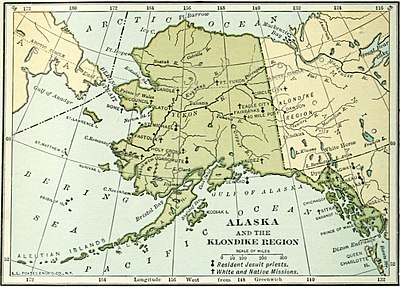cation of the Eskimos and Indians remained under the control of the Secretary of the Interior, and provision is made for the work by an annual appropriation ($50,000 in 1905). The principal elements of this public education for the natives are the teaching of the English language, spoken and written, and the arts of reindeer-herding and transportation, helpful at once to the white man and the native. (Statement 351 of the Commissioner of Education to the Secretary of the Interior, 30 June, 1905, 26–48).

VII. Native Tribes—Pagan Superstitions, etc.—The Alaskan aborigines fall into four major divisions or groups: (1) The Aleuts, who occupy the whole of the Aleutian Islands, the north coast of the Alaskan Peninsula, from Cape Stroganof westward; (2) the Ten'a, or western Athabascans, who are spread over the interior of the territory on both sides of the Yukon river as far west as Koserefsky. A belt of Eskimo hems them in on the northwest and south and separates them completely from the ocean except at one point near Cook's Inlet on the North Pacific; (3) the Thlinkets, or Koloshes, as the Russians call them, who people the islands and coasts of southeastern Alaska; and (4) the Eskimo, or Innuits, who are scattered along the coastline from Alaska to Labrador. These different groups are subdivided into families, subdivisions which are based mainly on linguistic differences. Like most northern tribes they were at one time, and still are in some degree, addicted to Shamanism, or sorcery, which enters intimately into all their relations, personal, social, and civil. An occult influence, they believe, resides in certain persons, and is hereditary, being transmitted with its mysteries and paraphernalia (masks, drums, straps, bones, etc.) to sons and grandsons. It enables them to reveal the future, to discover lost or hidden things, and with preternatural assistance to avoid misfortunes or disasters. It assures them among their misguided votaries credit for infallibility and makes them in the eyes of believers mediators between the visible and invisible worlds. Ivan Petroff, in his "Population, Resources, etc. of Alaska" (embodied in the United States Census Report for 1880), describes the Shamanistic ceremonies of initiation, incantations, etc. Veniaminof (John Popoff) the most authoritative Russian writer on Alaska, says, "It is a very rare occurrence that the son of a Shaman adopted the trade of his father. Probably the Shaman on his death-bed forbade his son to do so, explaining to him the worst side of his position, and turning his desires in another direction. Many of the Shamans call their occupation the service of the devil, and told the young men that nobody who had any fear or apprehension must lay claim to the title of Shaman, and that they themselves had not adopted the profession voluntarily, but because they were powerless to resist the devil." There were, of course, numerous errors in a religion allied to such practice. Nevertheless, we do not subscribe to the statement (p. 13) in "Handbook 84 on Alaska", issued by the Bureau of American Republics, Washington (1880): "Except as their ideas are modified by relations and intercourse with white people, they have no religion, unless certain definite superstitions, having no connections with an definite idea of a supreme supernatural being, be called religion." On the contrary, it can be seen in the writings of Petroff, Holemberg, and Veniaminof that they possess certain elements of religion. Thus, every tribe recognized a Creator, termed in the tradition of the coast Nunalukhta; throughout the archipelagic circle, Agoughouk; among the Kodiaks, Shliam-Shoa; and along the narrow strip to the southeast, Yeshl, or Yehl. They held an immortality and a state of retributive rewards and punishments even beyond the grave, and this in the uncommon case of cremation of the body. They exhibited at
